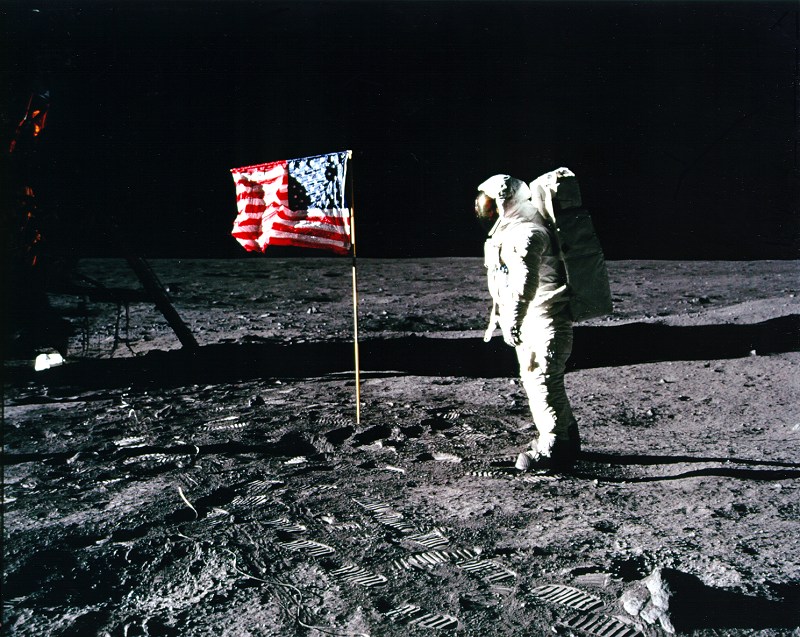The Myth of America's Love Affair with the Moon

This story is part of a week-long SPACE.com series on what it would take for humanity to return to the moon to stay. Also coming on Friday on SPACE.com: Mining the moon.
An enduring American legend holds that the U.S. space program enjoyed broad enthusiastic support during the race to land a man on the moon. In reality, polls show that levels of public support look remarkably similar today as they did 50 years ago.
Public opinion in favor of continuing human lunar exploration almost never rose above 50 percent during NASA's Apollo program – but the lone exception was in October 1965. Americans often ranked spaceflight near the top of programs to be cut in the federal budget during the 1960s buildup toward the first moon landing.
"It's contrary to what the space community wants to believe," said Roger Launius, space history curator at the Smithsonian's National Air and Space Museum.
The only time when more than half of the public believed Apollo was worth the expense came at the time of the Apollo 11 lunar landing in 1969, when Neil Armstrong took humanity's first steps on alien soil. Even then, only a lukewarm 53 percent of the public believed such a momentous historical occasion had been worth the cost.
Such findings suggest that the United States went to the moon not because the public demanded it, but because U.S. presidents and Congress believed it served a greater political purpose during the Cold War, Launius said. He added that any future U.S. effort to send astronauts to the moon would also require a similar political, economic or national defense reason to compel funding for the effort.
The absence of such a reason may have made it easier for President Barack Obama's administration to move to end NASA's Constellation program last year. That program had aimed to return U.S. astronauts to the moon. Instead, however, Obama has proposed an equally ambitious quest to send astronauts to an asteroid and then Mars.
Get the Space.com Newsletter
Breaking space news, the latest updates on rocket launches, skywatching events and more!
Crunching the numbers
The good news for space exploration in general is that public opinion favors it – but only when not taking economic costs and budgetary spending into consideration.
"When you divorce it from the numbers and you ask people if they like NASA and spaceflight, people say yes," Launius told SPACE.com. "75 to 80 percent are in favor."
The space historian examined nationally representative polls done by industry people and Gallup that asked the same consistent questions year after year. He also looked at polls conducted by the New York Times and others.
Public support for overall space funding has hovered around 80 percent in favor of the status quo since 1965, except for a major dip in support during the early 1970s. That may bode well for NASA's continued existence, but it also suggests that few people are clamoring to throw even more money at the space agency.
Budget myths
Still, polls also show a huge misconception regarding the cost of the U.S. space program. Public opinion has wrongly put NASA's budget at about 22 percent of the government's spending over the years, when in fact NASA's budget only reached 4.3 percent of the federal budget at its peak in 1965.
Since the 1970s, the U.S. space agency's budget has hovered below 1 percent of government spending.
"My suggestion is that NASA is so visible and the space shuttle is such a powerful icon that people believe this stuff must cost an enormous amount of money," Launius said.
As for 2010, NASA's budget came in at just six-tenths of 1 percent of all government spending. Neither side of the political aisle seems to have any real interest in boosting NASA's budget, according to Launius.
NASA also seems unlikely to get a dramatic budget boost in the near future. While an October 2010 NASA authorization bill signed by the president called for a slight increase in the space agency's funding, that money has yet to be appropriated. Instead, NASA and all other non-military government agencies have been frozen at their 2010 funding levels by a Congressional continuing resolution (a stopgap until a full budget can be agreed upon) that holds until March 4.
Finding a prime directive
U.S. space agency funding in recent years has depended upon certain congressional interests in protecting NASA-related jobs, as well as a fuzzier "feel-good" sentiment toward keeping the space agency afloat.
If NASA ever wants to get a bigger budget to send astronauts back to the moon or beyond, it will need to find compelling reasons – whether they're related to the search for life or a precious "unobtanium" resource worth going after and exploiting, some experts say.
Launius also suggested that the lack of political support for returning astronauts to the moon is related to the bigger question hanging over the purpose of human spaceflight – or rather, the lack of clearly defined purpose.
"There's an inability of the aerospace community – and I include myself here – to articulate a clear, irrevocable, unassailable rationale for doing this," Launius said.
Join our Space Forums to keep talking space on the latest missions, night sky and more! And if you have a news tip, correction or comment, let us know at: community@space.com.
Jeremy Hsu is science writer based in New York City whose work has appeared in Scientific American, Discovery Magazine, Backchannel, Wired.com and IEEE Spectrum, among others. He joined the Space.com and Live Science teams in 2010 as a Senior Writer and is currently the Editor-in-Chief of Indicate Media. Jeremy studied history and sociology of science at the University of Pennsylvania, and earned a master's degree in journalism from the NYU Science, Health and Environmental Reporting Program. You can find Jeremy's latest project on Twitter.









